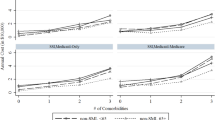Abstract
The experience of Medicaid recipients in the public mental health system is examined for a cohort of new users with respect to time spent in treatment and patterns of care. The analysis shows that 47% of the user cohort do not receive services again over the 4-year study period. Approximately 25% are found to be using services 4 years later, 19% of whom are continuous users throughout the period. These long-term users tend to be the most seriously mentally ill based on diagnosis and disability status and display patterns of care that shift, over time, from inpatient care to outpatient services. Inpatient services were used by 29% of the new cohort during their first year in treatment which has implications for managing mental health care since a large percent of crisis patients are new or unknown to the system each year.
Similar content being viewed by others
References
Goldberg, D., & Huxley, P. (1980).Mental illness in the community: The pathway to psychiatric care. London: Tavistock Publications.
Harvey-Smith, E. A., & Cooper, B. (1970). Patterns of neurotic illness in the community.Journal of the Royal College of General Practitioners, 19, 132–39.
Horgan, C. (1985). Specialty and general ambulatory mental health services: Comparison of utilization and expenditures.Archives of General Psychiatry, 42, 565–572.
Keeler, E. B., Wells, K. B., Manning, W. G., Rumpel, J. D., & Hanley, J. M. (1988). The demand for episodes of mental health services.Journal of Health Economics, 7, 369–392.
Kessler, L. G. (1984). Treated incidence of mental disorders in a prepaid group practice setting.American Journal of Public Health, 74, 152–154.
Kessler, L. G., Steinwachs, D. M., & Hankin, J. R. (1980). Episodes of psychiatric utilization.Medical Care, 18, 1219–1227.
Kiesler, C. A., & Sibulkin, A. E. (1987). The Medicare and Medicaid programs. InMental hospitalizations: Myths and facts about a national crisis (pp. 228–237). Newbury Park, CA: Sage Publications.
Kochhar, S., & Scott, C. G. (1995). Disability patterns among SSI recipients.Social Security Bulletin, 58(1), 3–14.
McGuire, T. G., & Fairbank, A. (1988). Patterns of mental health utilization over time in a fee-forservice population.American Journal of Public Health, 78, 134–136.
National Center for Health Services Research and Health Care Technology Assessment. (1987).National medical expenditure survey, NMES (DHHS Publication No. PHS 89-3440). Washington, DC: U.S. Government Printing Office.
Rothbard, A. B., (1993).The general physician's role in the mental health treatment of the seriously mentally ill. NIMH Grant #1 R29 MH50036-01A1.
Rothbard, A. B., Schinnar, A. P., Hadley, T. R., & Rovi, J. I. (1990). Integration of mental health data on hospital and community services.Administration and Policy in Mental Health, 18, 91–99.
Rothbard, A. B., Foley, K. (1995).The general physician's role in the mental health treatment of the seriously mentally ill Paper presented at the 123rd Annual Meeting of the American Public Health Association, San Diego, CA.
Rowland, D., Rosenbaum, S., Simon, L., & Chait, E. (1995). Medicaid and managed care: Lessons from the literature. Washington, DC: The Kaiser Commission on the Future of Medicaid.
Rupp, K., & Scott, C. G. (1995). Length of stay on the Supplemental Security Income Disability program.Social Security Bulletin, 58 (1), 29–47.
Rupp, A., Taube, C. A., Bodison, D., & Barrett, S. A. (1987). Medicaid and ambulatory mental health care: Utilization and cost. In R. W. Manderscheid & S. A. Barrett (Eds.),Mental health, United States, 1987 (DHHS Publication No. ADM 87-1518). Washington, DC: U.S. Government Printing Office.
Schinnar, A. P., Rothbard, A. B., & Kanter, R. (1991). Adding state counts of the severely and persistently mentally ill.Administration and Policy in Mental Health, 19, 3–12.
Wells, K. B., Keeler, E., & Manning, W. G. (1990). Patterns of outpatient mental health care over time: Some implications for estimates of demand and for benefit design.Health Services Research, 24, 773–789.
Whitmore, R. W. (1983). Medicare and Medicaid best estimation for theNational Medical Care Utilization and Expenditure Survey (NMCUES), 1980: Final report to the Health Care Financing Administration. Research Triangle Park, NC: Research Triangle Institute.
Author information
Authors and Affiliations
Rights and permissions
About this article
Cite this article
Rothbard, A.B., Schinnar, A.P. & Adams, K. The utilization of Medicaid mental health services. Adm Policy Ment Health 24, 117–128 (1996). https://doi.org/10.1007/BF02042484
Issue Date:
DOI: https://doi.org/10.1007/BF02042484



